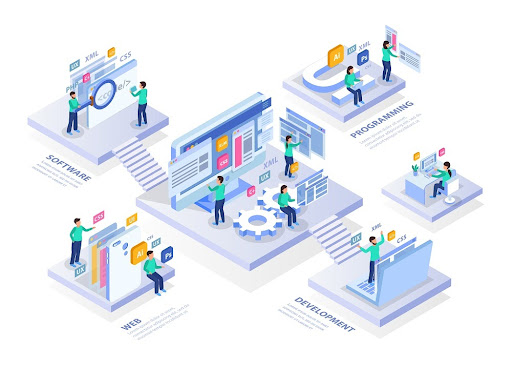Recently while talking to a client, I spent more than two hours trying to enlighten her how the agile model is more suitable for her app & the waterfall model will lead to unnecessary waste of time & resources over the project.
Are you considering the waterfall model for your project?
I agree that a waterfall model is an excellent option. However, it’s only when you have a distinct vision and there’s hardly any room for improvement during the development course.
With the software product development market having a CAGR of 11.3% from 2021 to 2028, almost every entrepreneur & established enterprise is eager to try their hands in digital solutions. It seems an ultimate idea to become a renowned unicorn in the competitive market.
However, on the contrary, business owners need to do a lot of homework to ensure they are at par while talking to a hired team of experts.
Among diverse aspects, the Software Product Development Life Cycle plays a crucial role for anyone to rein in the project and ensure quality development.
In this article, you can find the following four significant aspects related to SDLC.
- What is a Software Product Development Life cycle?
- What are its seven stages?
- Tips for selecting the best Software Development Lifecycle Model for your project
- Top 5 Product Development Life Cycle approaches.
So next time, you can make quick & better decisions in choosing the ideal model for your project.
Let’s Start With Explaining What Exactly The Software Product Development Life Cycle Is?
Software Development Life Cycle refers to a detailed methodology and set of procedures used in software development. It involves several stages that help develop and test an application before it is finally released into production or made available to end-users.
More often than not, SDLC refers to the seven stages involved in developing software applications, namely Analysis, Design, Build, Test, Implement, Deploy, and Maintenance.
These stages are highly interdependent, with some being more important than others depending on project requirements. Some of these may also have sub-stages, while all are equally important for building successful applications.
Decoding the Software Product Development Life Cycle Stages:
Stage 1: Requirement Analysis
The first stage of software product development identifies whether there is a need for your software or not. As humans, we tend to think that more technology is better. It helps us organize, plan & make informed decisions. But it can’t solve every problem. Or does it.
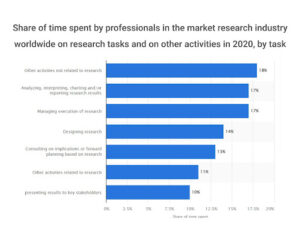
Source: Statista- Time Spent on Research
The software allows people to collaborate more effectively. Yet, there still may be some communication bottlenecks. Or even miscommunication with colleagues or clients, depending on how you work together/communicate.
The users of your product or service, what they want or need, what you can do for them that’s different from what your competitors offer. Knowing who you are solving a problem for allows you to write user stories.
Stage 2: Feasibility of The Project
The feasibility stage begins with gathering user information through customer interviews and other means. It usually takes through sketching and other forms of prototyping, which will lead to screen layouts that coders can test with potential users.
It should become clear whether your product will be viable to sell based on what you learned in Stage-1. If not, it’s time to go back to square one and start over! If so, you’ll continue to do it.
Note: As per experts, requirement gathering & feasibility study are the most crucial stages for ensuring rapid growth and success of the project. Statista says 42% of startups fail by investing in a product with nil market needs.
Stage 3: Designing Phase
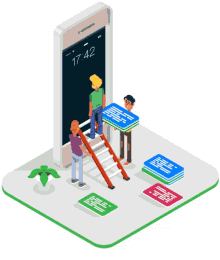
In stage 3 of the development life cycle, the design of the product is finalized and worked upon. It means the developers work out precisely what they will build and start forming a roadmap for getting there. A lot of care & attention goes into making sure your software works as you want it to.
Not a bit more & not a bit less. So, it takes time and effort on your part as well. You should know how each feature will function, what those features do and why they’re essential.
However, don’t get too bogged down in detail at first as you don’t want to hold up the development of your M.V.P. (Minimum Viable Product). This stage can take anywhere from three weeks to three months, depending on how complex your app is; more on that later.
Stage 4: Coding Phase
The coding phase of the SDLC involves writing code to accomplish tasks identified during requirement analysis. Developing a program or application comprises translating high-level software requirements into detailed specifications, which programmers then implement through source code.
At this stage, standard tools used for coding include various integrated development environments (IDEs), Integrated Unit Testing frameworks, Coding standards checkers, and so on.
It would be helpful if you took utmost care while coding. Any error here could hamper efforts in succeeding stages, leading to mistakes at other stages or, even worse, security flaws introduced in your application.
Stage 5: Testing & Debugging
This stage is closely related to quality assurance (Q.A.) and user acceptance testing (UAT). It involves testing different aspects of the software to determine whether it meets all software requirements and performs as expected.

Source: Statista-Detected Malicious Packages
While QA refers more generally to any tests carried out on software, UAT typically relates to tests that take place towards the end of development or after deployment to help ensure changes have not broken existing functionality.
Testing may include stress testing, which checks whether a system can function normally under heavy loads. If these fail, then coders would use regression Testing to check for bugs. If there are no bugs found in regression testing, then Beta Testing can occur, which uses real-world simulations of how customers use your product or service.
Stage 6: Installation & Deployment
Finally, the developer’s team deploys the developed software. This stage should be mostly familiar to you by now, so let’s go over a few key differences. First of all, deployment may require a bit more time. The team needs to create a server, upload your code, and test for bugs or incompatibilities with other programs.
Just remember that once you launch a new feature on your site, don’t touch it again until after at least two weeks have passed. You might have forgotten something vital in an old version of your code that could affect newer features.
Repeating all stages from ground zero is always a good idea when upgrading or releasing new features into production environments.
Stage 7: Software Maintenance
At this stage, you will continue to support and make updates as needed based on users’ feedback. If any bugs or errors arise, correct them and ensure that all systems and software remain operational and running smoothly.
It’s also essential to check for security issues and other potential problems that may affect your software during Stage 7 of a Software Development Life Cycle (SDLC). Since bugs can enter at any point in time, including at the maintenance stage, it’s vital to keep monitoring your program throughout all phases of an SDLC.
However, because there won’t be significant changes to your software during the maintenance stage, it won’t take as much time & effort as in earlier stages.
Choosing the Compatible Software Development Life Cycle Model:
Step-1: Analyze & Determine your Requirements

The first step in choosing a compatible model is to assess your needs. Every organization faces different challenges, so it’s essential to consider your particular environment when deciding what’s best for you.
In addition, it’s also vital that you understand there are no right or wrong choices as far as process models go. The key is finding a model that aligns with your goals and objectives and fits your existing infrastructure.
Step-2: Assess the Needs of Stakeholders
If you’re designing a new system, what do you need it to do? What features should it have? How will its end users use it? Business owners must ensure they understand what their company needs from an I.T. solution.
Please make sure you know who your stakeholders are and which of their needs are most important. If there are uncertainties or disagreements among decision-makers, now is an excellent time to resolve them before proceeding with your next steps.
Taking care of these early steps will save you money in the long run. Any ambiguities at this stage can lead to severe problems down the road—and ultimately cost more than you think.
Step-3: Learn About the Various SDLC Models


Whether you’re just starting your software development process or you want to improve it, there are a few models that can be of great help. If you already have a project going, review each model and decide which one best suits your company.
If you’re currently developing a new product, try writing down a list of must-have features and then choose a model based on those needs. Remember: not all companies use every model.
In the later section of this article, we will discuss the top 5 SDLC models you can use for your development project.
Step-4: Look for Project Compatibility with the Model
The right project fit with an SDLC model is like making sure you choose your vehicle before driving into traffic. It’s not enough that your car can get you to work; it needs to be compatible with other cars on the road.
Not every project is compatible with every development method, so take time before choosing a plan to ensure it fits your organization’s goals and strategy. For example, methodologies like Scrum or Kanban might be best if you need more frequent changes throughout product development.
Weigh your options by analyzing different SDLC models to ensure you are with the right fit.
Step-5: Decide & Optimize the Model
The last step in choosing an SDLC model is figuring out which best fits your business needs. After determining your long-term goals, consider these factors when choosing a model:
- Costs,
- Project complexity,
- Resource skills and availability,
- Market demand, and
- Feasibility of target deadlines.
It’s also worth noting that you can leverage more than one model for different projects or even different parts of a single project.
The 5 Standard Models That Show Common Approaches To Applying Specific Tools Within An Overall Strategy:
1. Waterfall Model
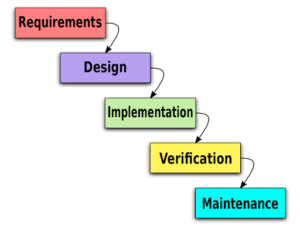
Source: Wikimedia
The waterfall model for software development is one of the most common models. Notably, it’s also among the heavily criticized models for its inflexibility & resistance to change. However, it’s not all bad. Its structured approach makes it easy to follow while limiting changes in scope, so your project isn’t drifting off-course.
Essentially, each phase of your project must be complete before you move on to working on another stage. There are no changing directions halfway through a project.
The waterfall model allows for minimal changes in scope and gives you a clear picture of what is necessary—step by step, making it easier to make decisions & control costs.
Suitable for projects: If your development project has a fixed & clear vision about the final product, then Waterfall is a proven excellent option to proceed with the project.
2. Agile Model
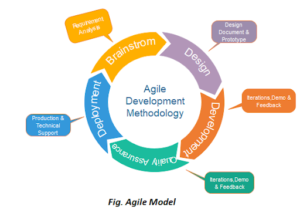
Source: Javatpoint
Agile is a group of development methods that are iterative, incremental, and evolutionary. Agile team members break their work into small units of code called stories, prioritize them by importance & necessity, and develop them in small chunks over a short period (usually 2-4 weeks).
The team then gets it into users’ hands as soon as possible to collect feedback. This iterative process continues until they have developed something that satisfies customers’ needs well enough to be released.
Suitable for projects: Projects with limited time zones and significant complexity are well suited to Agile methodology.
3. Spiral Model
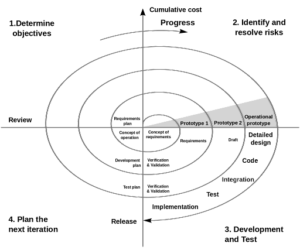
Source: Wikipedia
The spiral model offers a sequential approach to software development in which a series of steps repeat in a continuous cycle. The cyclical nature of the spiral made it a handy model for projects with unpredictable timelines and extended feedback loops.
Because you’re constantly going through cycles, you have time to make adjustments and iterate on new approaches throughout your project life cycle. There are two distinct types of spiral models: open-ended and closed-ended. Within each class, you can choose from three iterations: system-centered, object-centered, or activity-centered.
Each offers unique benefits, but there is no one definitive spiral model best for every business or project—your needs will determine which model works best for your company or project goals.
Suitable for projects: Software product life cycles that need to be developed based on users’ feedback are ideal for spiral models.
4. DevOps Model
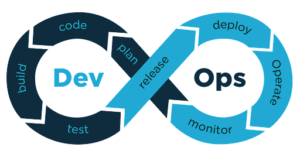
Source: Medium
This approach ensures that development and operations teams work together seamlessly, often preventing integration problems or outages. DevOps methods emphasize automating tasks and using tools like version control systems, virtualization, and configuration management.
The ideal environment for a DevOps strategy is a setup where you have both development and operations running in tandem on multiple domains at once with built-in quality checks throughout each development step. On top of that, it should be convenient to roll back changes if something goes wrong without disrupting other parts of the system.
Suitable for projects: It is ideal for large & complex development projects with limited time in hand.
5. Scrum Model
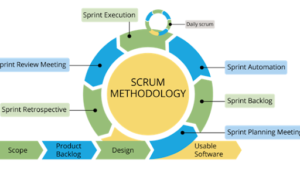
Source: Educba
This method of development typically follows agile development principles. While it is primarily helpful for software development, Scrum is also beneficial in project management for other applications.
To accomplish a goal, teams focus on quickly developing products by incorporating user feedback at each process step. It also focuses on small team sizes to ensure that each person has a vital role in helping achieve project goals.
While programmers may most widely use it in software development, you can apply Scrum to nearly any field with just some minor adjustments. Its versatility makes it one of the top five SDLC models.
Suitable for projects: Ideal for development projects requiring end users’ views on each development phase.
Wrapping Up
Whichever model you implement in your company, ensure that your team members have read through all available documentation on that specific process and adhere strictly to its guidelines. Otherwise, you’ll never reach the perfect harmony between everyone involved in a project.
That said, one size does not fit all when it comes to Software Product Development Life Cycle—it mainly depends on how your team works together best. The more you can understand your team’s work process, the better you can utilize whichever models suit them best.
FAQs
Q1: How can we secure the SDLC model?
A1: Like any other technology or process, you need to ensure that your Software Development Life Cycle (SDLC) is secure. There are many threats and challenges you need to be aware of while working with SDLC. When building out an application, there are several areas where it is crucial to be vigilant about security Access control.
Ensuring all users have access only to what they need while preventing others from accessing resources they shouldn’t have access to. It can range from proper identification mechanisms on a network level through passwords and biometrics, right down to database constraints on a database server.
Additionally, you’ll need to make sure that applications are not accessible over open networks, which could give an attacker access to data or even allow them to manipulate your application.
Penetration testing will help you ensure that your application is secure against hackers and third parties. Internal auditing will ensure that your organization’s information security systems are up-to-date and effective.
As with any tool, it is better to know about these potential issues before deploying an application, so there are fewer unexpected problems down the road.
Q2: How many SDLC models are out there in the world?
A2: You might be startled to learn that several variations of software development life cycle (SDLC) models are out there. If you’re like most people, you’ve likely never heard of more than two or three in your lifetime.
Numerically there are more than 50 SDLC models available out there.
Q3: What is the bug life cycle?
A3: The bug life cycle is a process in which a bug goes through to get fixed. It begins when a user reports an issue with a product or software. Next, there’s an investigation into how widespread that issue is and whether or not it’s a bug. Finally, once it gets confirmed as a bug, there are steps to getting it fixed and released into production.
In general, fixing bugs is part of what’s known as the software development lifecycle (SDLC). It is typically an iterative process during which issues are found and dealt with over time. It is a tedious task for developers because of all of these steps – but without them, it would be hard to ensure that products worked well.

